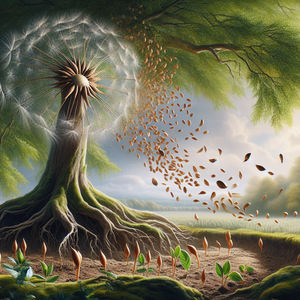The Quiet Rebellion of a Petal Collector

Picture the petal collector at work. The scene is the antithesis of what modern society celebrates. There are no roaring crowds, no flashing cameras, no metrics of productivity ticking away on a screen. Instead, there is quiet. At their desk, the archivist gently cups a single petal in the palm of their hand, its edges curling inward like a whispered secret. Each vein running through the petal tells a story—a story of seasons, soil, and sunlight. With the precision of a surgeon and the patience of a monk, they study the petal under soft light. A tiny brush clears away specks of dust, and tweezers lift the fragile fragment of nature onto an archival sheet. This is more than preservation; it is reverence. In a world obsessed with multitasking and the rush of novelty, the petal collector rebels by practicing singular focus. Their work is an invitation to slow down, to look closer, and to rediscover the beauty that hides in plain sight. Where society prizes newness and speed, the archivist honors the timeless and the delicate. Their rebellion is as much about philosophy as it is about craft—a quiet challenge to the chaos of modern life.
Rejecting the Noise
The botanical archivist lives at odds with mainstream culture. They are not drawn to the frenzied energy of sports arenas, nor do they partake in the endless scroll of social media feeds. Instead, they find their joy in the quiet corners of the world, where wildflowers bloom unnoticed and petals drift to the earth like forgotten treasures. To the petal collector, rejecting the noise of the world is not an act of disdain but a deliberate choice. They see the richness of life not in the spectacle of competition or the speed of technological advances, but in the intricate details of nature. A single petal, to them, is a microcosm of life itself. It tells a story of the ecosystem it came from: the climate that nurtured it, the soil that fed it, and the season that shaped its colors and contours. In preserving these fleeting fragments of beauty, the archivist speaks a language few take the time to learn. They see nature as a vast dictionary, and each petal they collect and preserve is a word in that dictionary—a word that might otherwise be lost.
The Craft of Preservation
The rebellion of the petal collector is not just a philosophical stance; it is embodied in their meticulous craft. This is not a hobby; it is an art form, a science, and a labor of love. Flowers are not simply plucked and pressed at random. The archivist studies their subjects with the care of a historian, considering factors like the flower’s origin, its season of bloom, and even the cultural significance of the species. The process of preservation is painstaking. Factors such as humidity, light exposure, or even the acidity of the paper used in pressing can mean the difference between success and failure. Some petals require weeks to dry, their colors deepening or fading subtly as they relinquish their moisture. Others are so fragile that even the softest touch can damage them irreparably. Each preserved petal becomes a bridge between moments—a token from the past that can be held, studied, and cherished in the present. In a world where so much is disposable, the archivist’s work is a quiet testament to the value of preservation. It is a reminder that beauty, no matter how fleeting, is worth saving.
A Rebel with a Gentle Cause
The petal collector may not see themselves as a rebel, but their work is undeniably subversive. In a society that measures success by speed and productivity, they choose to slow down. In a culture that glorifies spectacle and noise, they find meaning in the small and the quiet. Their rebellion is not about tearing down existing systems, but about offering an alternative. Their work serves as a gentle nudge—a reminder that there is beauty in stillness and grace in fragility. It challenges the rest of us to reconsider what we value and why. It would be easy to dismiss the work of a botanical archivist as quaint or inconsequential. But to do so would be to overlook the profound statement their work makes. Each preserved petal is a story, a fragment of an ecosystem, and a piece of history that might otherwise be forgotten. In their quiet way, the petal collector is an archivist of wonder, preserving not just petals but the emotions and moments they represent.
The quiet rebellion of the petal collector is an invitation—to you, to me, to anyone who feels overwhelmed by the relentless pace of modern life. It invites us to slow down, to look closer, and to cherish the fleeting beauty that surrounds us. The petal collector reminds us that not all pursuits need to be loud or fast to be meaningful. Their work challenges us to find joy in the overlooked and to appreciate the fragility of the world around us. In a world that often measures worth by productivity and spectacle, the petal collector’s rebellion is deeply profound. They preserve what others might overlook. They reject the chaos of the world in favor of its subtler joys. And they remind us, in their quiet way, that true strength lies not in dominance or speed, but in care, patience, and a willingness to see beauty where others see none. The petal collector’s rebellion is not one of anger or defiance, but one of love—for nature, for stillness, and for the enduring power of preservation. Will you join them?
Botanical Archivist
Natural history museums, botanical gardens, research institutions
Responsibilities
Document and preserve plant specimens, focusing on their ecological and cultural significance.
Utilize preservation techniques such as pressing, drying, and mounting to create long-lasting botanical records.
Collaborate with botanical gardens, museums, or herbariums to expand collections and research plant data.
Skills Needed
Expertise in botanical taxonomy and plant identification.
Knowledge of archival standards and preservation materials.
Attention to detail and the ability to work with fragile specimens.
Environmental Historian
Universities, environmental organizations, publishing houses
Responsibilities
Study and document the relationship between humans and nature throughout history.
Research how specific ecosystems, plants, or landscapes have influenced cultural development.
Write and present findings in academic journals, books, or public exhibitions.
Skills Needed
Strong research and analytical skills with a focus on environmental topics.
Ability to synthesize historical records, oral histories, and scientific data.
Excellent writing and storytelling abilities to convey findings to diverse audiences.
Floral Designer and Preservation Artist
Artisan studios, floral boutiques, event planning companies
Responsibilities
Create intricate floral arrangements with both fresh and dried flowers for artistic or commercial purposes.
Develop unique preservation techniques to transform flowers into long-lasting decor or keepsakes.
Collaborate with clients to design personalized floral art that celebrates special moments or memories.
Skills Needed
Strong aesthetic sense and creative vision.
Proficiency in preservation methods like resin encapsulation, pressing, or freeze-drying.
Exceptional communication skills to understand client needs and deliver custom designs.
Herbarium Technician
Universities, research institutions, conservation organizations
Responsibilities
Manage and maintain herbarium collections by cataloging, preserving, and digitizing plant specimens.
Prepare plant samples for scientific research, ensuring proper storage and labeling.
Assist researchers by providing access to specimens and supporting fieldwork efforts.
Skills Needed
Familiarity with herbarium software and digital imaging tools.
Knowledge of plant taxonomy and collection protocols.
Organizational skills to handle large, detailed collections.
Conservation Photographer
Environmental NGOs, media organizations, freelance photography
Responsibilities
Document the beauty of natural environments, plants, and wildlife to raise awareness about conservation efforts.
Work closely with botanists, ecologists, or environmental groups to capture images that tell compelling stories.
Use photography to highlight endangered species or fragile ecosystems, inspiring action and preservation.
Skills Needed
Proficiency in photography techniques, including macro photography for capturing intricate details.
Ability to work in outdoor, sometimes remote, locations under varying conditions.
Storytelling skills to create impactful visual narratives.


